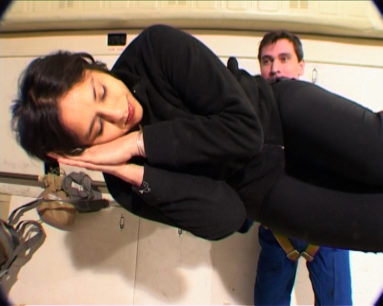The Otolith Group (Kodwo Eshun, Richard Couzins, Anjalika Sagar – Initial Report 3.0 On The Pilot Study On The Minimal Behavioural Preconditions For The Partial Demilitarization Of Permanent Habitation In Microgravity – 2003
Kodwo Eshun, cultural critic and curator. Richard Couzins, Anjalika Sagar, artists.
First publication symposium Visibility – Legibility of Space Art. Art and Zero G. : the experience of parabolic flights, in collaboration with the @rt Outsiders festival, Paris, 2003.
In the present Era of the Preemptive Strike, the likelihood of nuclear detonation is more intense than ever before. The search for habitable environments becomes a necessity rather than a diversion. This imperative led the OTOLITH GROUP to investigate the minimum preconditions for permanent habitation in microgravity. This Report presents the initial research into the environmental and behavioural conditions for long term agravic habitation.
On the morning winter light of April 7 2003, after an hour’s delay, the OTOLITH GROUP entered the Star City main gate. Once inside, a second hour delay impressed upon the Group the extent to which it was entering militarised, defensible space. It became clear that Star City provided the consensus-forming and rule-governing context for microgravity.
Within the Star City complex, the Yuri Gagarin Cosmonaut Training Centre consisted of the Virtual Space Academy and the Scientific Research Complex that housed the simulators designed to train cosmonauts for space flight. These simulators generated and contained the colossal forces necessary for orbit, resulting in a brutalist architecture of monumental mass. Unlike Hollywood, simulation here functioned to rehearse the dangerous reality of space.
Behavioural immersion in microgravity lay within the ILYUSHIN 76, stationed at the military airfield some 15 minutes outside Star City. In preparing it’s experiments for microgravity, the OTOLITH GROUP gave considerable attention to the processes of spatial reduction, temporal distortion, weight loss and disorientation, all of which converged to make normal life abnormal.
Given these conditions, it made no sense to impose a zero G-spectacle. On the contrary, the GROUP were concerned to design situations that maximised the emergence of unanticipated material flux. The GROUP therefore adopted an anti spectacular logic that drew on the legacies of Ashtanga Yoga, Arte Povera and Conceptual Art.
More specifically, the mobile meditation and inward focus of yoga practice, the repeated actions of Robert Barry and the humble materials of Michael-Angelo Pistoletto served as precedents for the process of protracted reduction through which the GROUP arrived at 5 actions to be repeated for the duration of 25 parabolas. These were as follows: Combing hair while holding a mirror. Applying lipstick. Swallowing a vitamin pill. Reading a book. Writing a letter. Agravic space itself suggested a sixth action: sleeping.
In transposing habitual Earthbound actions to a non habitual space, the Group were able to test the minimal requirements for normal habitation in microgravity. In the context of intensive time, where the constants and constraints of 1 G-Load have either reversed or disappeared, these actions were designed to establish the psychosocial norms for life.
The experiments were successful on three counts. Firstly, they were normative to the degree that the Commander of the ILYUSHIN 76 himself failed to grasp an experiment was actually taking place. Secondly, this failure indicated the temporary demilitarisation of agravic space and the consequent creation of a partially domesticated space-time that constituted what Georges Perec called ‘a new species of space’.
During these 25 seconds, the masculine norms of the aeroplane cabin were infiltrated by an intimate, partially feminised affective dimension. In so doing a third result became evident; the actions initiated a zone of privatized concentration that felt out of place and out of time.
In their totality, these soft space-times catalysed a sense of concentration that partially explained why microgravity was experienced as powerful, not as powerless. The most vivid sensation was that of having gained a superpower, of an extension of power over a previously unattainable dimension of space.
The actions successfully indicated how agravic reorientation could clarify the dismal reality of the contemporary moment. The GROUP’s experiments allowed a relational field to emerge in which microgravity could be apprehended in all its psychoaffective materiality. This focus on fluctuation in turn brought the GROUP face to face with geopolitical reality in all its disorientation. Far from being a space of escapism then, agravic space here functioned to heighten the material awareness of planetary disorientation.
What lessons may be learnt from this pilot study into minimum conditions that might be applied to permanent offworld habitation? It is likely that subjects will have to undergo radical surgical intervention to the otolith. It is a question of whether we change the environment to respond to the human or alter the human to fit the environment.
Where will a modified human believe they come from? And where will they belong to, those humans who will live in a species of space so distinct from ours? Given the fact that gravity locates the human species, the condition of weightlessness immediately provokes fundamental questions of ground and foundation, roots and routes. The experimental behavioural scenarios of the OTOLITH GROUP are designed to dramatise these questions, questions that are simultaneously ontological, ideological, poetic and political.
End

© Kodwo Eshun, Richard Couzins et Anjalica Sagar & Leonardo/Olats, October 2003, republished 2023
Leonardo/Olats
Observatoire Leonardo des Arts et des Techno-Sciences
À propos / About | Lettre d'information Olats News



Pour toute (re)publication, merci de contacter / For any (re)publication, please contact Annick Bureaud: info@olats.org
Pour toute question concernant le site, merci de contacter / For any issue about the website, please contact: webmaster@olats.org
Design Thierry Fournier
© Association Leonardo 1997-2022